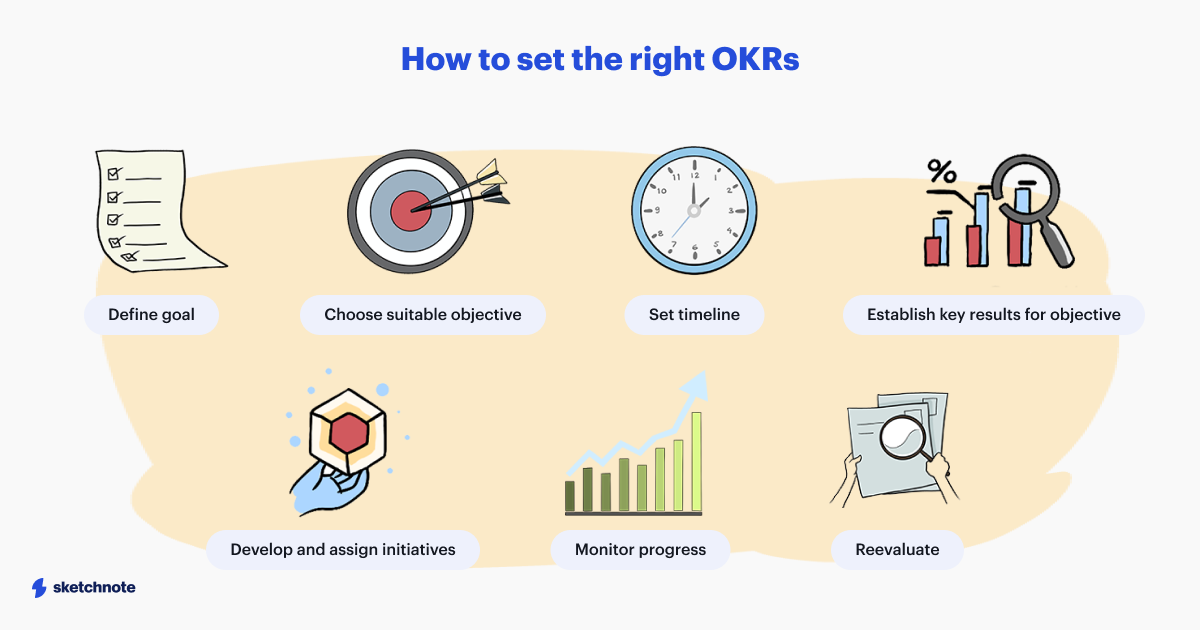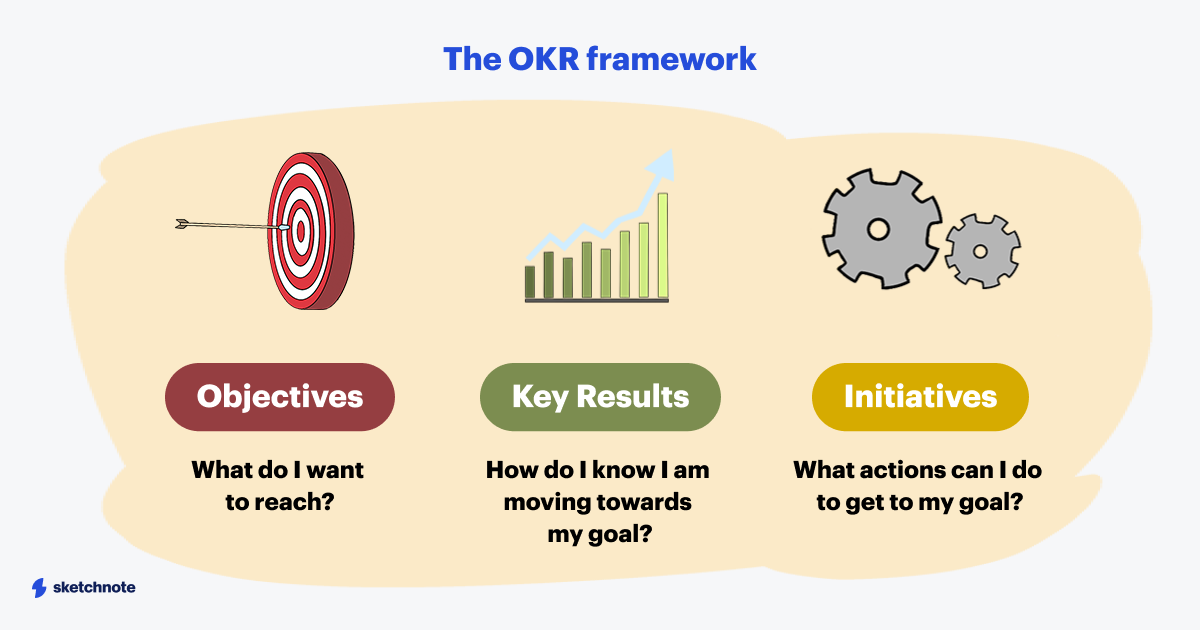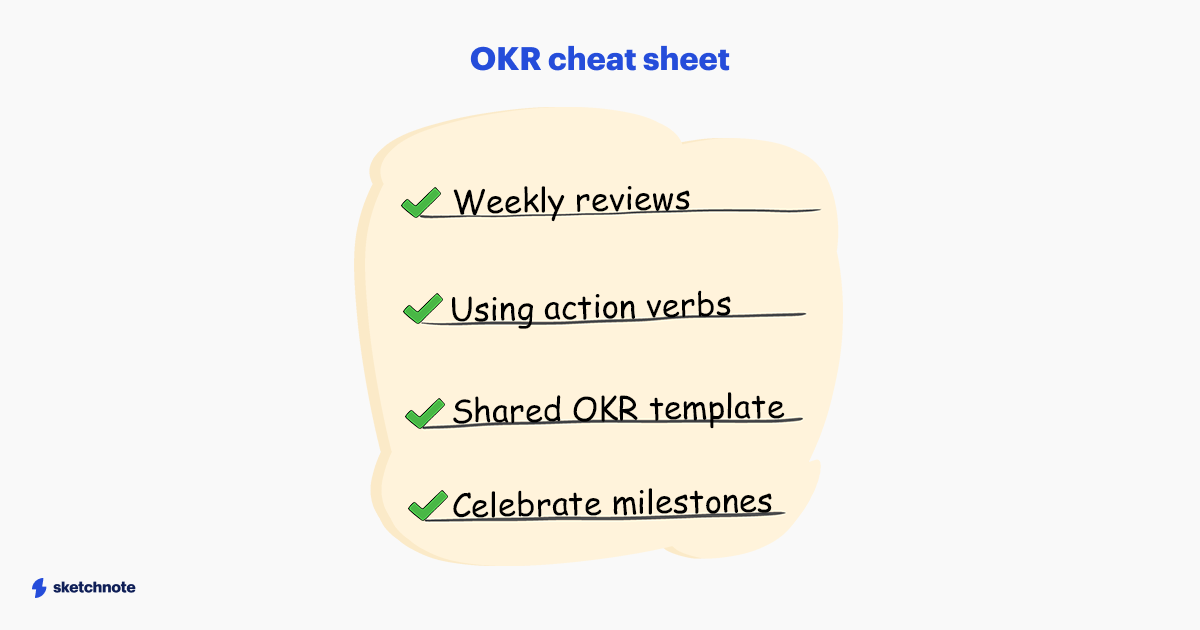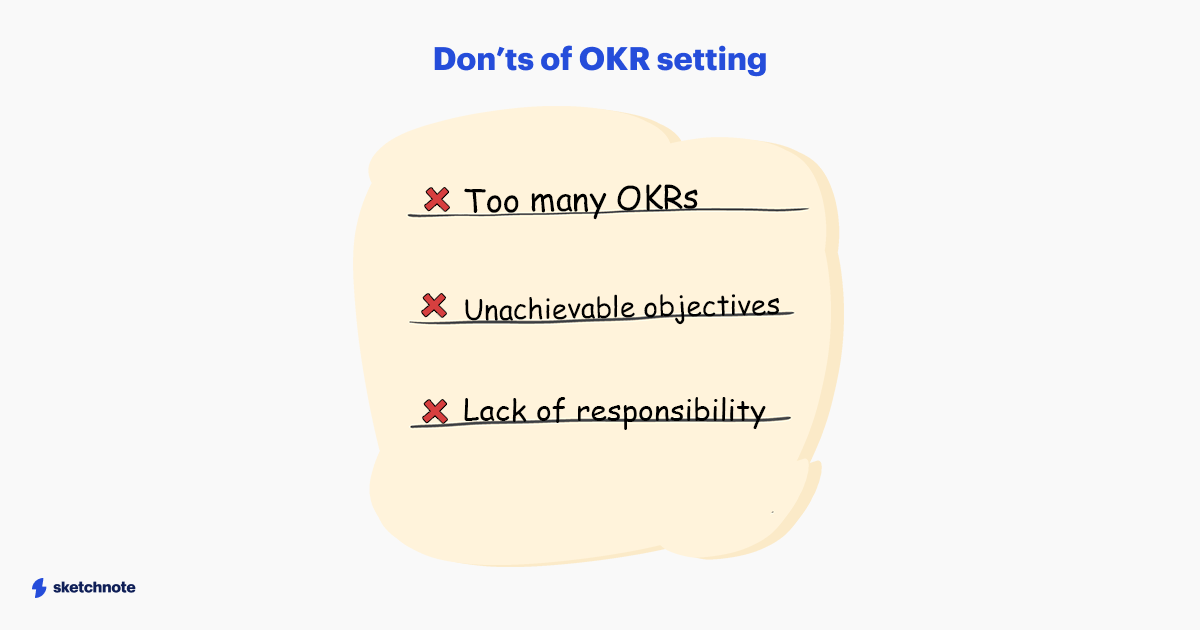Creating long-term goals is one of the most well-known ways to boost a team’s motivation and drive. However, most times the idea ends up being just that—an idea.
Usually, no actions follow great intentions if not observed, measured, and actively worked upon.
That’s where OKRs come into play.
But what exactly are OKRs?
OKRs stands for Objectives and Key Results.
The term finds its origin in Management by Objectives (MBO). It was coined by Peter Drucker back in 1954 where he defined that specific objectives can help organizational performance. However, OKRs truly became popular in its current format after John Doerr introduced the strategy to the founders of Google and made this a standard practice that the company still uses today.
The OKR framework has two components that mark the difference between having a long-term idea and making it a reality: Action and accountability.
The strategy is simple, basically founded in three major components:
- Objectives: “What do I want to reach?”.
It’s the specific goal you want to reach in a window of time. It has to be ambitious enough to make you slightly uncomfortable.
- Key Results: “How do I know I am moving towards my goal?”.
These are the quantifiable results that will make the objective achievable. Completing them will show progress towards the objective.
- Initiatives: “What actions can I do to get to my goal?”.
These are the specific actions that you can do to get closer to achieving your objective.

Steps to create your own OKRs
Now that we know what this goal-setting strategy is about, it’s time to put it into practice.
1. First things first: What do you want to achieve?
Before finding effective OKRs adapted to your startup’s situation, you have to think about what your goals are.
Do you want to become a leader in your industry? Do you want your product to be a leader in its field?
Once your vision and mission are clear, make sure you communicate them with your team. This will give everyone a sense of shared direction for their actions and a purpose in common in which you can set your OKRs.
2. Choose objectives suitable for your startup.
Not all startups are the same, and this has to reflect in the OKR strategy that each organization chooses.
It wouldn’t make sense for an early-stage startup that still hasn’t been able to find its niche to have the same objectives as a growth-stage startup, with a successful product already on the market, right?
Once that is clear, make sure you choose an objective aligned with your company’s vision and mission. Your objective should have these main characteristics:
- Challenging: It has to be something that pushes you out of your comfort zone, slightly out of your team’s reach and capabilities. Be ambitious.
→ Here’s a tip: If it makes you uncomfortable to say it aloud, you are doing it right.
- Precise: Write your objective in a sentence. Everyone should easily understand it, and it shouldn’t need further explanation.
- Monitored: As explained in the beginning of this article, what makes OKRs different from other strategies is the consistent action and measurement of results.
The objective can’t only be an idea; it must be followed by action, and the progress should be scrutinized.
3. Set up a timeline for your goal.
Usually, OKR objectives are annual or quarterly, although the second is preferred to avoid being too abstract.
Company-wide objectives tend to be annual because the purpose is to guide and direct the startup towards a specific direction, which takes time.
However, objectives set for specific teams or individuals are quarterly because they have more immediate results.
4. Establish your Key Results for each Objective.
Once your objectives are set and clear, it’s time to establish how you’ll know you are reaching your goal.
You can base yourself on these three main characteristics when setting up your Key Results:
- Specific: Key Results must be clearly defined.
- Measurable: Its progress can be quantified numerically.
- Time-bound: It has to be achieved in a timeframe, with a previously fixed deadline.
5. Develop and assign your Initiatives
Start developing the specific actions you will use to reach those Key Results, and assign them to their corresponding owner.
The owner of the initiative will be responsible for its completion and monitoring. To create proper initiatives, think about these two main characteristics:
- Clearly defined: It can explain in one line what the task is.
- Achievable: The initiative should be a task the owner can complete on their own. Every owner has to be fully accountable for the accomplishment of their initiatives.
6. Monitor your progress
Once everything is established, and everyone on the team is on board, it’s time to keep track of the advances of your strategy.
It’s crucial for both leaders and team members to actively engage in this step.
Monitoring the progress of your OKRs will keep everyone accountable while showcasing the actions that are working and the ones that have to be changed, keeping the OKR strategy in constant improvement.
7. Reevaluate
Once the period you set for your OKR objectives is over, evaluate your results.
If you have missed your goal by a big stretch, it’s time to reflect on the problem that made you miss the mark. As well as how you can set better goals in the next period. You should always encourage your team to join you in this process.

OKR examples for early-stage startups
Now, let’s put these steps into practice. Here are some examples you can follow when creating your early-stage startup’s strategy:
Marketing OKR Example
Objective: Our social media platforms become our primary source of clients.
KR1: We reach 200K followers on Instagram.
KR2: 10K people subscribe to our newsletter.
Initiative: We post three pictures and two reels every week on Instagram for two months.
Initiative: We create a discount code for everyone that joins our newsletter.
Customer Support OKR Example
Objective: Our annual Customer Satisfaction Score is above 4.5
KR1: We decrease our response time to three hours.
KR2: Decrease negative Social Media interactions to less than five per month.
Initiative: We hire two more people exclusively for customer support before November.
Initiative: We establish a customer support phone line before the end of the quarter.
Development OKR Example
Objective: We become the ‘go-to’ company for X program.
KR1: Our Weekly Active User rate grows from 13% to 40%.
KR2: 10k people subscribe to our free trial.
KR3: 20% of people who subscribe to our free trial upgrade to a paid membership.
Initiative: We launch a $2,000 LinkedIn ads Campaign to high management roles in the field to promote our free trial.
Initiative: We hire two more people before June 31 to work in our communication department and provide our clients with excellent customer service.
Initiative: We successfully develop a loyalty program with mid to long-term benefits and discounts before the end of the year.
OKR examples for growth-stage startups
Sales OKR Example
Objective: We reach a new annual revenue record.
KR1: We increase our Monthly Revenue Record (MRR) from $100k to $280k.
KR2: The percentage of annual subscription renewals increases by 20%.
Initiative: We create a new offer for long-time users that renew their plans.
Initiative: We launch a social media campaign with 20 influencers that promote our service.
Company OKR Example
Objective: We successfully position ourselves in the European market.
KR1: We close 30 partner deals in the continent.
KR2: Our quarterly revenue from European sales reaches $2.0M
Initiative: Attend five industry events in Europe.
Initiative: Open three new locations in Europe before the end of 2022.
Product OKR Example
Objective: We successfully launch our new product line to the market.
KR1: We achieve a 2% conversion rate with our Instagram Ads campaign.
KR2: 25% of our free trial subscribers end up buying our product.
Initiative: Create a notification system that alerts our users when the trial period is going to end.
Initiative: We have an exclusive, time-limited discount for the free trial subscribers if they become paid users.

Tips to create your OKRs
Following the previous steps will definitely put you on the right track to achieving your goals. However, every beginning can be somewhat challenging, and that’s why we have collected some extra tips to boost your OKR success:
- Schedule weekly reviewing sessions with your team. This will keep everyone accountable and constantly on track with the OKRs.
- Use action verbs (such as write, contact, release, etc.) when creating your Initiatives, and avoid using ambiguous verbs like improve, help, etc.
- Create a shared OKR template with examples and send it to your team. Having examples to look up to can simplify ideas and help you explain the OKR strategy to others.
- Celebrate small victories and milestones. The positive reinforcement and recognition of your team’s efforts and progress will encourage them to continue putting in the effort to achieve the Objective.

What pitfalls should you avoid when creating your OKRs?
Here are the three most common mistakes businesses make when using OKRs for the first time:
- Setting too many OKRs: We recommend that you keep your Objectives to less than three and no more than five Key Results per Objective.
- Objectives too unachievable: It’s necessary to be ambitious, but not unreasonable. You should have OKRs that are a little bit aggressive but not impossible for your startup. If you start being too unrealistic, your team may not believe in this strategy.
- Lack of responsibility: If you assign the responsibility to a whole team for the completion of an objective, chances are that no one in that team will feel directly responsible for the task. You need to directly assign one team member for this and hold them accountable.
Summary
As you can see, the OKR framework is a simple and effective method that you can apply to your startup at any stage of its development to boost your productivity and help you achieve your goals more effectively.
Use our examples above for guidance and start setting your first OKRs. Good luck!



